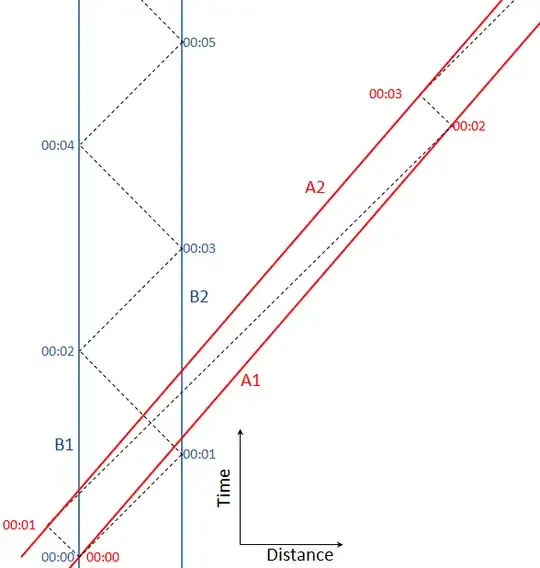Two open-car trains approach each other at fixed velocities. Each has a radar to see how quickly the other train is approaching, but apart from that the trains have no a priori knowledge of each other.
Each train has engineers on its first and last cars. Each engineer has an atomic clock and a laser for communicating with their partner on the same train. Long before the trains meet, the engineers on each train use their lasers to adjust their relative separations to exactly one kilometer. Using the synchronization procedure first defined by Einstein, the engineers also exchange time data and use it to adjust their atomic clocks until they are precisely synchronized within their shared frame.
The trains meet. The clocks are positioned so that they almost touch as they pass. At the moment of nearest contact, they exchange and record each other's values (timestamps).
Some time later, the clocks on the trailing cars meet and perform the same procedure.
The delay between the leading and trailing data events can now be measured in two ways.
If the two timestamps taken from the first train are compared, the result is the time between the events as measured from the first train. This value is meaningful because the engineers on that train previously synchronized their clocks and stayed within the same frame of reference at all times. If the timestamps from the second train are used, a similar but distinct measurement of the time between the two events can be obtained.
Now, three questions:
Is there anything wrong or impossible with this experimental setup? If so, what is it?
If you accept the experiment as realistic and meaningful, will the delays calculated from the perspective of each of the two trains be the same, or different?
If you answered "different," what is the correct procedure for predicting in advance what the ratio of the two delays will be?
2013-01-10 - The Answer(s!)
I awarded the bounty to @FrankH for pages of excellent and educational work worth of reading by anyone who wants to understand special relativity better.
However, I've also taken the unusual step of re-allocating the answer designation to @MatthewMcIrvin.
There are two reasons: (1) Matthew McIrvin was the first one to spot the importance of the symmetric-velocities frame, which others ended up gravitating (heh!) to; and (2) Matthew's answer is short, which is great for readers in a hurry. FrankH, sorry about the switch, but I didn't realize I could split them before.
So: If you are not overly familiar with special relativity and want to understand the full range of issues, I definitely recommend FrankH's answer. But if you already know SR pretty well and want the key insights quickly, please look at Matthew McIrvin's answer.
I will have more "proximate data exchange" SR questions sometime in the near future. Two frames turns out to be a very special case, but I had to start somewhere.
For folks with strong minds, stout hearts, and plenty of time to kill, a much more precise version of the above question is provided below. It requires new notations, alas.
To reduce the growing size of this question, I have deleted all earlier versions of it. You can still find them in the change history.
Precise version of the 4-clock conundrum
Please see the first three figures below. They define two new operators, the frame view and clock synchronization operators, that make the problem easier to state precisely:



Note that the four timestamps $\{T_{A1}, T_{B1}, T_{A2}, T_{B2}\}:>\{A,B\}$. That is, the four timestamps are shared and agreed to (with an accuracy of about 1 nanosecond in this case) by observers from both of the interacting frames A or B. Since T1 and T2 are historically recorded local events, this assertion can be further generalized to $\{T1,T2\}:>*$, where $*$ represents all possible frames. (And yes, $:>$ is two eyes looking left, while $<:$ is two eyes looking to the right.)
Using the four shared time stamps, define:
$T_{\Delta{A}} = T_{A2} - T_{A1}$
$T_{\Delta{B}} = T_{B2} - T_{B1}$
My main question is this:
Assuming that $T_{\Delta{A}} = f(T_{\Delta{B}})$ exists, what is $f(x)$?
Analysis (why this problem is difficult)
Based purely on symmetry in the setup, the most obvious answer is $f(x)=x$, that is:
$T_{\Delta{A}} = T_{\Delta{B}}$
There are some interesting reasons to be troubled by that seemingly straightforward and even obvious conclusion, not the least of which is that it violates the whole concept of special relativity (the Dingle heresy).
That is, if you assume $f(x)=x$ and follow that line of logic through to its logical conclusion, you quickly end up with time that flows the same for all frames -- that is, no relativity. Such a conclusion is in flat violation of over a century of very detailed experimental evidence, and so is just not supportable.
The following four figures show why it's so hard to assert that $T_{\Delta{A}} = T_{\Delta{B}}$ without violating special relativity.




While the above figures accurately capture the reality of relativistic contraction of both distance and time, the problem in this case is simple: How do you decide which frame to select? The experiment as described can only give one outcome. Which one will it be?
